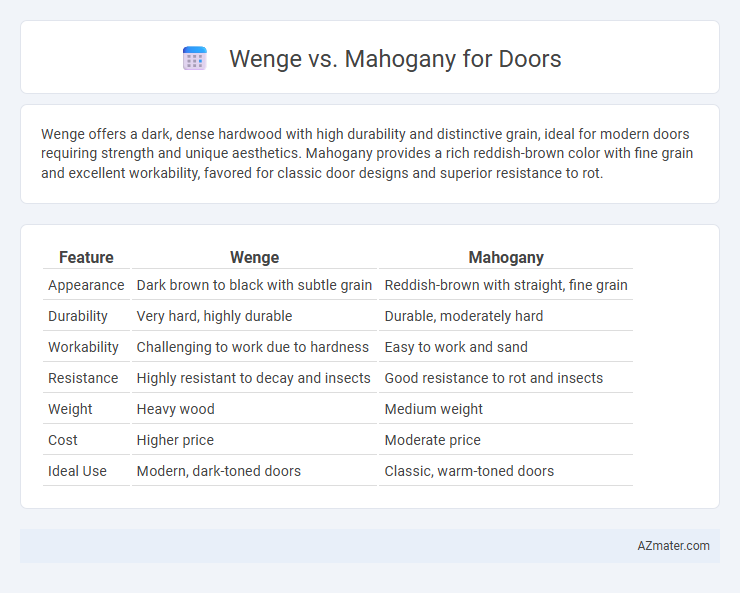Wenge offers a dark, dense hardwood with high durability and distinctive grain, ideal for modern doors requiring strength and unique aesthetics. Mahogany provides a rich reddish-brown color with fine grain and excellent workability, favored for classic door designs and superior resistance to rot.
Table of Comparison
| Feature | Wenge | Mahogany |
|---|---|---|
| Appearance | Dark brown to black with subtle grain | Reddish-brown with straight, fine grain |
| Durability | Very hard, highly durable | Durable, moderately hard |
| Workability | Challenging to work due to hardness | Easy to work and sand |
| Resistance | Highly resistant to decay and insects | Good resistance to rot and insects |
| Weight | Heavy wood | Medium weight |
| Cost | Higher price | Moderate price |
| Ideal Use | Modern, dark-toned doors | Classic, warm-toned doors |
Introduction to Wenge and Mahogany Wood
Wenge wood, sourced primarily from Central Africa, is prized for its deep chocolate-brown color with distinctive dark veins and exceptional durability, making it a popular choice for high-end doors. Mahogany wood, originating from tropical regions of the Americas and Africa, features a rich reddish-brown hue and uniform grain, known for its strength, resistance to rot, and ease of finishing. Both woods offer premium aesthetics and structural integrity, with Wenge providing a more exotic appearance and Mahogany delivering classic warmth.
Origin and Availability of Wenge vs Mahogany
Wenge wood originates primarily from Central Africa, specifically the Congo Basin, with limited but increasing availability due to sustainable harvesting efforts, while Mahogany is native to the tropical regions of the Americas, particularly Honduras and Brazil, known for its wider global distribution. Wenge's dense grain and dark color make it a sought-after exotic hardwood, but its availability may fluctuate due to strict export regulations. Mahogany offers more consistent availability in the marketplace, supported by plantations and responsible forestry management.
Physical Appearance and Color Differences
Wenge wood features a dark, rich brown color with subtle black streaks, giving doors a bold, dramatic appearance, while mahogany displays a warm reddish-brown hue that deepens over time, offering a classic and elegant look. The pronounced straight grain pattern of wenge contrasts with the smoother, more uniform grain of mahogany, contributing to distinct textures in door finishes. Both woods provide durable options, but their unique colors and grain patterns cater to different aesthetic preferences in door design.
Durability and Hardness Comparison
Wenge wood exhibits exceptional durability and hardness, measuring around 1630 on the Janka hardness scale, making it highly resistant to dents and wear for door applications. Mahogany, while still durable, typically rates between 800 and 900 on the Janka scale, indicating it is softer and more prone to surface damage compared to Wenge. For doors requiring superior robustness and longevity, Wenge offers a significantly harder and more durable option than Mahogany.
Workability and Ease of Finishing
Wenge wood offers high workability due to its coarse and dense grain, making it suitable for detailed door carvings but requiring sharp tools to prevent splintering. In contrast, mahogany is prized for its smooth texture and uniform grain, allowing easier cutting, sanding, and finishing processes, which results in a flawless, polished door surface. Mahogany's natural oils enhance stain absorption, while wenge demands careful sealing to achieve an even finish without blotching.
Cost Considerations: Wenge vs Mahogany
Wenge wood typically costs more than mahogany due to its rarity and dense, dark grain, making it a premium choice for doors with a unique aesthetic. Mahogany offers a more affordable price point while still providing excellent durability and a rich, warm appearance, often favored in classic door designs. Cost considerations also include availability; mahogany's widespread use and plantations lead to lower prices, whereas wenge's limited sourcing can increase expenses for larger projects.
Resistance to Moisture and Insects
Wenge wood exhibits superior resistance to moisture due to its dense grain structure, making it less prone to warping or swelling in humid environments compared to mahogany. Mahogany, while naturally resistant to insects, demonstrates moderate durability against moisture, requiring proper sealing to prevent damage over time. For door applications in moisture-prone or insect-infested areas, wenge offers enhanced longevity and reduced maintenance needs.
Environmental Impact and Sustainability
Wenge wood, sourced primarily from tropical African forests, is considered less sustainable due to slower growth rates and high risk of overharvesting, contributing to deforestation concerns. Mahogany, especially certain certified varieties like Honduran mahogany with FSC certification, offers a more sustainable option because of better-regulated harvesting practices and faster natural regeneration. Choosing sustainably harvested mahogany can significantly reduce environmental impact compared to Wenge, supporting responsible forestry and conservation efforts.
Ideal Applications for Doors
Wenge is ideal for modern and contemporary door designs due to its dark, rich color and dense grain, which offers exceptional durability and resistance to wear. Mahogany suits traditional and classic door styles, providing a warm reddish-brown hue with fine texture and excellent workability, making it perfect for intricate carvings. Both woods perform well in exterior and interior door applications when properly treated, balancing aesthetic appeal with structural strength.
Which Wood is Best for Your Door?
Wenge offers exceptional durability and a rich dark brown color with black streaks, making it ideal for doors requiring strength and a modern aesthetic. Mahogany is prized for its warm reddish-brown hue and fine grain, providing a classic, elegant look with good resistance to decay. Choose Wenge for a bold, contemporary design prioritizing hardness, while Mahogany suits traditional styles demanding smooth texture and timeless beauty.

Infographic: Wenge vs Mahogany for Door
 azmater.com
azmater.com